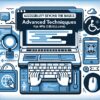Simplified Web Page Layouts with CSS Multiple Columns

Hello amazing seekers of web development knowledge! Let’s dive straight into the delightful world of web page layouts, using our magic wand – CSS Multiple Columns (neat, right?).
When I said "magic wand", I did mean that. CSS Multiple Columns is a superhero in the whacky, wild, and wonderful universe of CSS Styling. This caped crusader saves us from complications and confusion, making our web page layouts spontaneously smash into shape. How? Well, let’s crack the code.
The Power of CSS Multiple Columns
First of all, CSS Multiple Columns is quite literally your friendly, neighborhood Spiderman. Okay, it doesn’t sling webs or save Queens, New York from super-villains. Well, not New York, but certainly it saves your code from a mess.
Here’s how it works: The CSS multiple column layout allows easy definition of multiple columns of text – just like in newspapers! No super-complicated code, no rocket science involved.
Simplicity is the key to crack the code. Or in this case, ‘easy readability’ is the key to crack the webpage layouts!
Putting CSS Multiple Columns to Work
Keyword alert: simplicity! The CSS Multiple Columns makes use of simple properties that dramatically ease our layout creation process. Before you get too excited, bear in mind that with great power comes great responsibility – and syntax!
The properties include:
column-count: This determines the number of columns in the layout.
column-gap: As you guessed, it’s the space between columns.
column-rule: This is the line drawn between columns (play nice, columns!).
Syntax? Coming right up!
Below is a code snippet that creates a three-column layout with 20 pixels of gap between columns and a solid rule:
Yes, that’s it. Rest assured, there are no magical incantations or spellbooks behind those four lines of code that you need to decipher.
Adding Some Spunk with Span
Did you ever imagine that web page layout, and not just your high school sweetheart, could be won over with just a ‘span’? (Okay, bad pun, but I couldn’t resist!)
The ‘column-span’ property is perfect for those elements that need some extra space and attention.
Yes, even those special images get a chance to shine!
The Cross-Platform Compatibility Conundrum
Like every superhero, CSS Multiple Columns does have its kryptonite: cross-browser compatibility. Though it’s mostly supported by modern browsers, you wouldn’t want to leave any user in the lurch, would you?
So, for the old-school Internet Explorer, a little extra line of code will do the trick:
You see, even coding has some good manners – leaving no user behind!
And, there you have it! You can now create a neat, newspaper-like layout with CSS Multiple Columns. Go be the superhero your web page layout needs.
Remember, coding is just your superhero journey. Keep cracking codes, keep saving layouts, and most importantly, keep laughing at my jokes!


